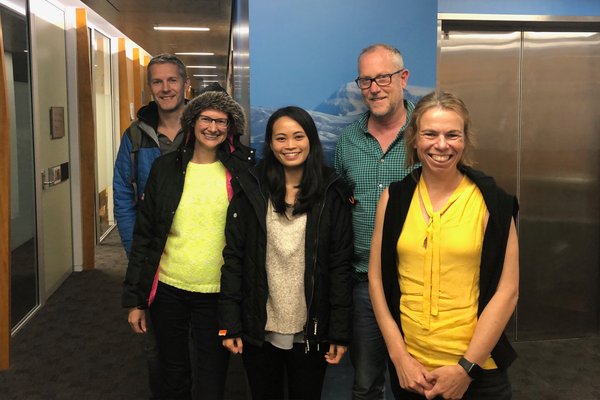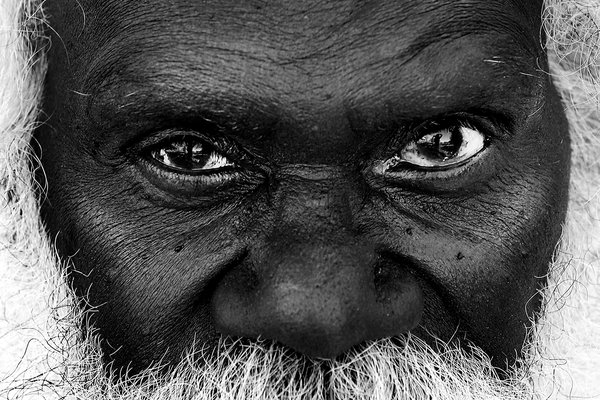Meet the interdisciplinary team studying factors that keep Indigenous languages strong
Who Lindell Bromham, Xia Hua (Australian National University) Felicity Meakins (University of Queensland), and Cassandra Algy (Karungkarni Art and Culture Aboriginal Corporation)
What Bringing together an Indigenous community member, linguist, mathematician and biologist, this team is studying Gurindji, an Indigenous language of northern Australia. Their research is developing new ways to understand the processes of language change and factors that help keep Indigenous languages strong and vibrant.
Winners of the 2021 Eureka Prize for Excellence in Interdisciplinary Scientific Research

Cassandra Algy Nimarra and Felicity Meakins record director-matcher tasks with Jamieisha Barry Nangala, Regina Crowson Nangari and Quitayah Frith Namija
Image: Jennifer Green 2017© Jennifer Green 2017
You are a four-person team that brings together skills from a broad range of fields. How did you initially come to work together on this project?
Felicity and Cassandra have worked together for the past two decades, documenting the way the Indigenous language Gurindji is used by different generations in the remote communities of Kalkaringi and Daguragu in the Northern Territory. They have built up the largest corpus of language recordings of any Australian Indigenous language. The connection with Xia and Lindell came about through the Centre of Excellence for the Dynamics of Language (CoEDL), a multidisciplinary research network. Felicity recognised that the evolutionary approach that Xia and Lindell were taking to language evolution could be useful for understanding change in Gurindji over generations.
We could see the amazing potential of the Gurindji data to answer important questions in language evolution.
We could see the amazing potential of the Gurindji data to answer important questions in language evolution. Lindell still has the notes we scribbled the first time we met to discuss the Gurindji data over coffee – we could see that this was a perfect case study for applying methods from evolutionary biology to language change. In fact, we were so excited we could hardly contain ourselves!
Can you tell us a little about the role that each of you play in the team’s research?
Cassandra is a talented researcher who makes the whole project possible, we couldn’t do this work without her. It’s important to have a local community member who can collect linguistic data because we don’t want people to modify their speech to make it easier for outsiders to understand. We want to capture how people in the community speak to each other. So, Cassandra a fluent speaker of Gurindji Kriol and member of the Gurindji community, is the centre around which the project revolves — she records people speaking, plays word games that reveal language variation, gets people to tell stories, supervises computer-based tests, and so on.
Felicity is a linguist who has been working on Gurindji for over two decades and has recently published a dictionary and a grammar of Gurindji, which is such an important achievement. Her detailed documentation of a new language that is emerging in this community, Gurindji Kriol, has made it one of the most well-studied cases of a mixed language — a language that forms from the fusion of two very different languages. It’s Felicity’s detailed knowledge of the processes of language variation and change that is the bedrock of this project.
It’s important to have a local community member who can collect linguistic data because we don’t want people to modify their speech to make it easier for outsiders to understand.
Lindell’s role as an evolutionary biologist is to see how we can frame the processes of language change in terms of evolutionary principles, and to work out a framework for asking interesting questions. She looked at Felicity and Cassandra’s data as a natural experiment in language change, where we can see the frequency of different language variants changing over generations. In many ways, the evolution of species, genes and languages are similar but in some important ways they are different. We need to think carefully about what ideas and methods we can adapt from evolutionary biology to looking at language change.
Xia is a brilliant mathematical biologist, trained as a biologist but now working in a mathematics department. She sees elegant analytical solutions to complex problems. She has both the evolutionary understanding and the mathematical skills to see how we can adapt classic evolutionary theory to work with language data – while some aspects of the theory are the same, in other ways the models must be modified to fit the way that language evolves differently from genes. Her solutions are both beautiful and practical!
Your work focuses on the processes of language change. What are some of the factors that help keep Indigenous languages strong and vibrant?
Thanks to the unique dataset that Felicity and Cassandra have constructed, we have information on so many aspects of language for such a large proportion of the community that we can investigate the way an individual’s life experience and environment shape the language that they use.
All languages change, but some change faster than others, and the language spoken in the Gurindji community is changing rapidly as the younger generations blend elements of Gurindji (the traditional language of this area) and Kriol (a newer Indigenous language spoken across much of northern Australia), along with new innovative features that are found in neither source language. But what influences that mix? We have shown that there are some factors that result in more Gurindji being used by members of the younger generations – for example, kids who have grown up with elders in their household tend to use more Gurindji language elements.
The most important, and worrying, result is that for all three generations — grandparents, parents and kids — the more years they spend at school, the less Gurindji they use. In this community, schooling is entirely in English, not in Gurindji. This result mirrors findings in other Indigenous communities around the world — monolingual education can result in an erosion of Indigenous language proficiency. In fact, the average number of years of schooling is a global predictor of language endangerment.
How can we use these findings to keep Indigenous languages strong? Bringing local languages into schools, and increasing the involvement of elders in education, could help to keep Indigenous languages vibrant and make sure they will keep being learned by younger generations. International research supports bilingual education not only as a way to improve Indigenous language vitality, but to improve educational outcomes in all areas of the curriculum.

Felicity Meakins and Cassandra Algy
Image: Brenda L Croft 2015© Brenda L Croft 2015
What has been the team’s most significant finding to date?
It is usually assumed that languages that are created through the contact between different languages — like Creoles or mixed languages — are simplified. Because we have data from three generations of people in the Gurindji community, we can track the way that elements of the traditional language Gurindji, and the newer language Kriol, have been combined to create the new mixed language Gurindji Kriol. We found that while the amount of Kriol in the mix increases each generation, this doesn’t seem to be due to preference for simplicity. Sometimes complex Kriol forms will be adopted over simpler Gurindji forms, and sometimes complex Gurindji language elements have been retained in the language even when there is a simpler Kriol alternative.
More generally, we have shown that with a big dataset and these new powerful analytical methods, we can test ideas about language change that have been debated for a long time, for example the role that generational differences or social groups within society play in language divergence over time.
What are some of the impacts you foresee — or hope to see — from the team’s research?
We hope that it will encourage others to work together across discipline boundaries! When you bring together Indigenous expertise, linguistic knowledge, evolutionary methods and mathematical tools, you can answer some really interesting questions.
This research focusses on a key part of Australia’s shared cultural heritage — our Indigenous languages — but more generally it helps us to understand the way that languages change over generations. For a language to thrive, it must be learned by children, but children change the language and make it their own.
When you bring together Indigenous expertise, linguistic knowledge, evolutionary methods and mathematical tools, you can answer some really interesting questions.
We are so grateful to Gurindji people for sharing their knowledge and language with us so that we can gain a better understanding of language change. We hope that by studying language change in this particular Indigenous community, we can shine a light on some of the factors that help to keep Indigenous languages strong, like time spent with elders, and schooling that encourages rather than inhibits Indigenous language proficiency.
What excites you about interdisciplinary scientific research?
We have found it such a privilege and an honour to work with each other, it has been one of the most joyful collaborations of our careers. Interdisciplinary research is hard — unlike working with people from the same field, you have to start from scratch to develop a shared language, common understanding, and mutual set of goals. And when you work outside your own discipline you always have so much to learn! That, to us, is what makes it so intellectually stimulating, being constantly stretched to think in a new way, take what you know and apply it in totally unfamiliar situations, learn fundamental concepts from another field, and get to grips with a whole new way of looking at things.
Luckily, all of us are very patient in answering each other’s questions, so every day of working together is a day when we are learning new and exciting things — we can’t believe how lucky we are!
The Australian Museum Eureka Prizes are the country’s most comprehensive national science awards, honouring excellence across the areas of research & innovation, leadership, science engagement, and school science.












